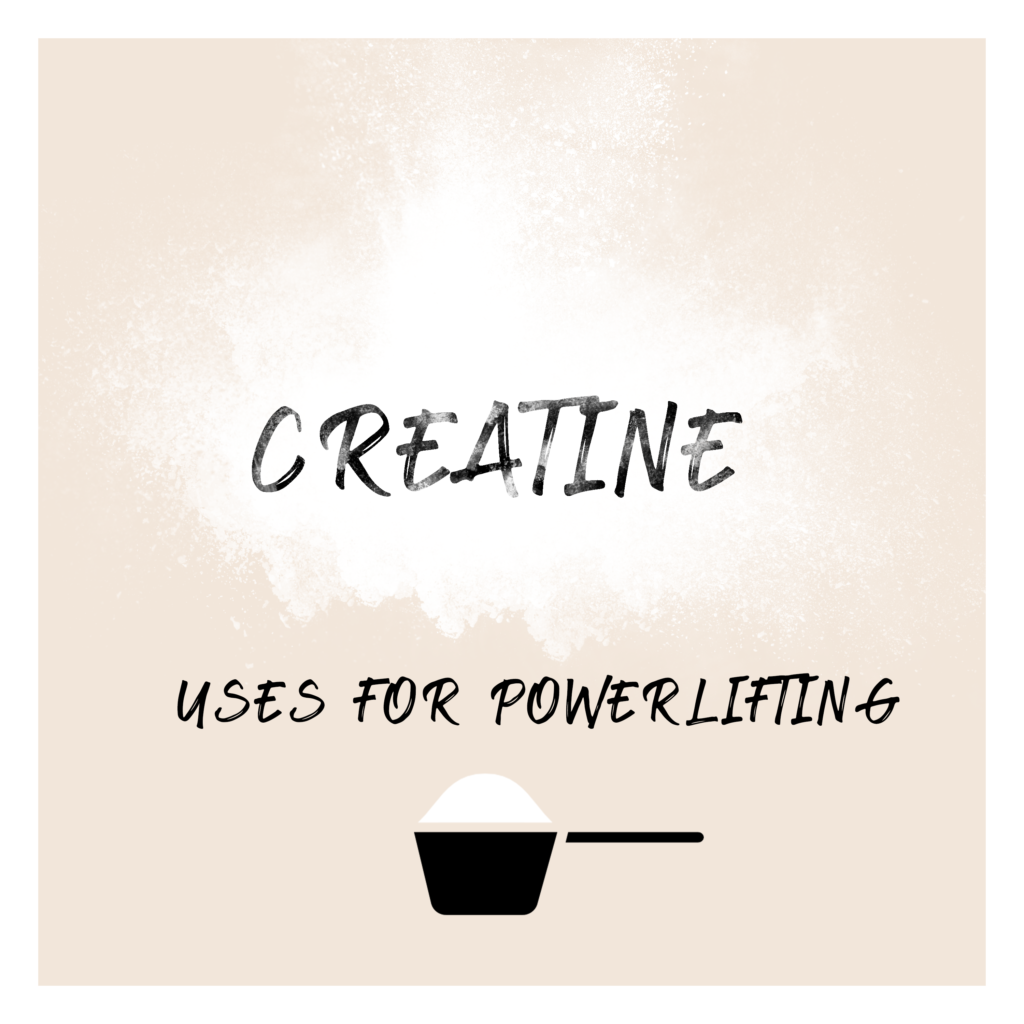
DYLAN SOH
Dylan Soh is a coach by name and nerd by heart. When he is not working with athletes or clients, he is reading research papers, watching anime, or playing with his cat. He serves as the Technical Director of Powerlifting Singapore, as a Strength and Conditioning coach in the Singapore Sport Institute, and has over 10 years of personal training experience.
Hi everyone! A while back the guys from ENSŌ asked if I can contribute some articles that may contribute to the local lifting community. We decided on creatine uses as it is relevant in the sport of Powerlifting, and because I just covered this topic back then with my fellow collaborator, Raymond Wang. The study that we covered was based on repeated rugby skill execution (cognitive) and they found that acute supplementation of creatine was beneficial in alleviating performance declines associated with sleep deprivation (Cook et al., 2011).
but how does that translate to powerlifting?
If you’re already supplementing creatine regularly (chronic), additional acute supplementation is unlikely to make any difference. The cognitive demands of Powerlifting are arguably low, as it is a closed skill sport where movement patterns are unaffected by the predictable environment (Wang et al., 2013).
so why do we supplement creatine?
During activity our body and muscles relies on the energy yielded by the breakdown of adenosine triphosphate (ATP), turning into adenosine diphosphate (ADP). Phosphocreatine (PC) breaks down to resynthesise ADP back into ATP. As this system takes just a one step process in providing energy for rephosphorylation, it is highly dominant in the first 10-15 seconds. Due to this, creatine is the most widely researched supplement.
analysis: powerlifting
By observing training videos and competition videos, the Squat 1 repetition max (1RM) is found to last the longest duration among the 3 competition movements (Squat, Bench Press, and Deadlift). The breakdown of the Squat duration is approximately 10 seconds from unracking of the barbell to bracing, and followed by approximately 1 second of eccentric phase. Using the average 1RM bar velocity of Powerlifters at 0.23m/s (Helms et al., 2017), we estimated 2-3.5 seconds in the concentric phase. This is also the most physically demanding phase of the activity. Lastly, the bar is brought under control after lockout and walked back into the rack. We theorise that the whole process of a 1RM Squat done in Powerlifting style will last around 15 seconds.
Illustration: Duration of a squat max attempt
what about the bench press and deadlift?
Deadlift done in the Powerlifting-specific style will likely be the shortest in duration. We can consider the start of activity during setup when the lifter applies force into the ground, followed by an eventual concentric phase of lifting the bar up. However, due to the rules governing the Deadlift, you will only have to maintain your grip on the barbell when it returns to the ground without a need to control the descent. Hence, there is minimal exertion and duration during the eccentric phase of the lift.
The duration of the Bench Press will be somewhere between the Squat and the Deadlift. The exertion kicks in during the unracking of the barbell, with a controlled descent onto the chest which comes to a standstill, before the press command is given by the head referee for the concentric phase of the lift. Although the average speed of the concentric phase of Bench Press is the slowest among the 3 lifts, the range of motion in the Bench Press is likely the shortest, and the unracking of the barbell does not involve taking steps out like the Squat.
training sets & longer duration variants
Powerlifters in training go beyond just single repetition sets. Depending on the phase of training, we may see athletes performing the main lifts in a higher range of repetitions. For example, a set of triples with the Squat can take approximately 30 seconds to complete, lasting longer when performed at a slower tempo or with a pause. It is rare for a Powerlifter to go much beyond 1 minute, let alone 2 minutes, where the aerobic system becomes fully dominant. Carry-over of training in this range to competition results will also arguably be poor.
energy system
Energy needs in Powerlifting can be simplified into an intense activity lasting between 15 to 60 seconds. The ATP-PC system is dominant in the first 10-15 seconds with the glycolytic system taking over dominance between the 10-60 seconds mark using glycogen and glucose as energy substrates. Note that all energy systems are active simultaneously, where predominance is based upon the duration of activity.
with the aTP-PC system lasting only 10-15 seconds, does creatine supplementation impact performance in higher rep training sets?
Yes it does. With more creatine available as energy substrates, this translates to a slightly heavier load or an additional 1-2 reps done at a similar rate of perceived exertion (RPE). Alternatively, if we were to equate the load and repetitions, it can result in a reduction of RPE as you would have more repetitions in reserve (RIR).
we understand that creatine is utilised in the ATP-PC system, but since our body already has it, why do we supplement it?
Creatine is produced (1-2g/day) in the liver, kidneys, and to a lesser degree, the pancreas, at 1 gram per day. There is only so much creatine our body can synthesise on a regular diet. Diets that exclude animal sources (vegan & vegetarian) will require further supplementation. Additional supplementation of creatine can increase creatine stores in our body by 20-40% (Kreider and Jung, 2011). There are no absolute dosage recommendations for creatine, as this is usually a range that varies with bodyweight or muscle mass.
what's the added benefit of creatine supplementation in powerlifting?
Creatine is involved as an energy substrate for contraction of skeletal muscle. The availability of more substrate creates a larger buffer against fatigue. This buffer feeds into an increased work capacity, leading to eventual increased strength performance and muscle growth (Kreider, et al., 2017).
what about the other benefits associated with creatine?
Firstly, creatine supplementation helps reduce the risk of injuries. Athletes who supplemented their diet with creatine have been found to have less incidence of muscle cramping, heat illness/dehydration, muscle tightness, muscle strains, and total injuries compared to athletes who did not supplement their diet with creatine (Greenwood et al., 2003).
Next, research has shown reduction in muscle damage and improvement of recovery with creatine supplementation (Cooke et al., 2009). The results were not replicated in an experimental design involving lower intensity, higher repetition range study (Rawson et al., 2006). In the context of rehabilitation from injury, limbs in cast experienced lesser atrophy and regaining of strength and muscle were faster with supplementation.
If your sport of focus is predominantly endurance and aerobic in nature, creatine will provide little benefit. Additionally high creatine storage will also cause increases in water retention, and this increased body weight might be detrimental. Imagine you’re a cyclist on a Tour de France stage covering 122-218km, where everyone is trying to reduce as much carried weight as possible. The reduction of mere 100 grams would bring marginal speed gains or wattage savings over your opponents.
risks of creatine supplementation
The literature has not provided any support that creatine promotes renal dysfunction or has long-term detrimental effects. In numerous well-controlled clinical studies, it shows that creatine supplementation does not increase the incidence of musculoskeletal injuries, dehydration, muscle cramping, or gastrointestinal upset. Unsubstantiated anecdotal claims in popular media as well as rare case reports described in literature without rigorous, systematic causality assessments have been refuted. Rather, creatine monohydrate supplementation has been found to reduce the incidence of many of these anecdotally reported side effects.
recommendations
iSSN Recommendations: general active population
1 Week of 20g loading phase (If you have not been taking) 3-6g per day (Maintenance)
our recommendations: strength athletes
1. Use well-known, tested brands: Beware of contaminated supplements
Supplements are not as heavily regulated as prescription drugs, and there are cases of supplement contamination where tainted supplements were found to contain banned substances.
The implications? Banned substances more often than not cause detrimental side effects to both your health and mental state. If you are competing in tested competitions, you can face sanctions as you’re liable for what you put into your body. Be true to the sport, be true to yourself!
2. Type
Creatine monohydrate provides the highest efficacy, is safe, and is the most widely studied form of creatine available on the market (Jäger et al., 2011). You can choose the micronised versions – which is more expensive – for better water solubility. Creapure is also recommended as a purer form of creatine monohydrate and has been lab tested for contaminants. This, unfortunately, makes it more expensive too.
3. Dosage
For competitive strength athletes, the recommended dosage is 5-10g/day. In higher dosages, there were no clinically significant or serious adverse events recorded in clinical populations with creatine synthesis deficiencies for years. Dosages used were 0.3 – 0.8 g/kg/day, equivalent to 21–56 g/day for a 70kg individual. (Kreider, et al., 2017; Braissant et al., 2011; Stromberger et al., 2003).
4. Timing
The recommended timing will be post-workout if you don’t regularly take creatine (Antonio and Ciccone, 2013; Ciccone et al., 2013). In cases of regular intake i.e. daily & high dosage, timing probably doesn’t make a difference as your creatine stores are already saturated.
how can we reach you?
references
Antonio, J., & Ciccone, V. (2013). The effects of pre versus post workout supplementation of creatine monohydrate on body composition and strength. Journal of the International Society of Sports Nutrition, 10, 36. https://doi.org/10.1186/1550-2783-10-36
Braissant, O., Henry, H., Béard, E., & Uldry, J. (2011). Creatine deficiency syndromes and the importance of creatine synthesis in the brain. Amino acids, 40(5), 1315–1324. Ciccone, V., Cabrera, K., & Antonio, J. (2013). Proceedings of the Tenth International Society of Sports Nutrition (ISSN) Conference and Expo. Journal of the International Society of Sports Nutrition, 10 Suppl 1(Suppl 1), P1–P28.
Cook, C. J., Crewther, B. T., Kilduff, L. P., Drawer, S., & Gaviglio, C. M. (2011). Skill execution and sleep deprivation: effects of acute caffeine or creatine supplementation – a randomized placebo-controlled trial. Journal of the International Society of Sports Nutrition, 8, 2.
Cooke, M. B., Rybalka, E., Williams, A. D., Cribb, P. J., & Hayes, A. (2009). Creatine supplementation enhances muscle force recovery after eccentrically-induced muscle damage in healthy individuals. Journal of the International Society of Sports Nutrition, 6(1), 13.
Greenwood, M., Kreider, R. B., Melton, C., Rasmussen, C., Lancaster, S., Cantler, E., Milnor, P., & Almada, A. (2003). Creatine supplementation during college football training does not increase the incidence of cramping or injury. Molecular and cellular biochemistry, 244(1-2), 83–88.
Greenwood, M., Kreider, R. B., Greenwood, L., & Byars, A. (2003). Cramping and Injury Incidence in Collegiate Football Players Are Reduced by Creatine Supplementation. Journal of athletic training, 38(3), 216–219.
Kreider, R. B., & Jung, Y. P. (2011). Creatine supplementation in exercise, sport, and medicine. The Journal of Exercise Nutrition and Biochemistry, 6(1), 53-69.
Kreider, R. B., Kalman, D. S., Antonio, J., Ziegenfuss, T. N., Wildman, R., Collins, R., . . . Lopez, H. L. (2017). International Society of Sports Nutrition position stand: Safety and efficacy of creatine supplementation in exercise, sport, and medicine. Journal of the International Society of Sports Nutrition, 14(1).

